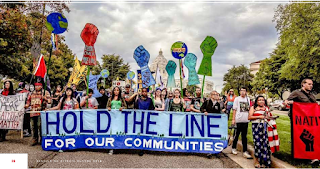Enbridge’s Line 3 so-called “replacement” project is a
proposal for a new pipeline that would cover more than 1,000 miles from
Hardisty, Alberta, to Superior, Wisconsin, transporting an average of 760,000
barrels of crude oil from the Alberta tarsands each day, with capacity for
844,000 barrels per day.
Enbridge intends to abandon its existing Line 3 pipeline if
it is able to complete its new Line 3, leaving the corroding pipe in the ground
and a lasting legacy of contamination. The replacement Line 3 would take a
brand new route. This path cuts through pristine wetlands and watersheds in
northern Minnesota, passing through the headwaters of the Mississippi River to
the shores of Lake Superior, through the heart of Minnesota’s lake country and
some of the largest and most productive wild rice beds in the world.
The proposed new Line 3 pipeline poses a grave threat to
Indigenous rights and culture. Its route would pierce the heart of the 1855
Treaty territory, where members of signatory Ojibwe bands retain the rights to
hunt, fsh, harvest wild rice, conduct religious ceremonies, and travel. Wild
rice harvesting lies at the core of Ojibwe culture and is explicitly defned asa
right in the treaties of several bands of Ojibwe with the U.S.government. The
fve directly impacted Ojibwe tribes along the Minnesota portion of the proposed
route are opposed to the project: the White Earth Band of Ojibwe, Mille Lacs
Band of Ojibwe, Fond du Lac Band of Lake Superior Chippewa, Red Lake Band of
Ojibwe, and Leech Lake Band of Ojibwe. The Line 3 pipeline project carries
risks that would violate the treaty rights of the Ojibwe peoples. Harm to the
wild rice beds of the Ojibwe people in this area threatens irrevocable and
devastating cultural impacts.
Enbridge has fought the environmental review process every
step of the way, leading to a courtroom battle that ultimately resulted in the
Minnesota Court of Appeals mandating a full Environmental Impact Statement
(EIS). At the end of 2017, the Minnesota Public Utilities Commission (PUC)
found Enbridge’s EIS to be inadequate, citing several issues that required
further clarity. When Enbridge argued that the inadequate EIS was sufcient for
the reviewing judge to make her fnal decision on the project, the judge
disagreed. However, the PUC ended up overturning the judge’s ruling in favor of
Enbridge’s arguments against including a full EIS in the ultimate project
decision.
In January 2018, the fve directly impacted Ojibwe bands
joined forces to appeal the decision of the Minnesota PUC toexclude a full
cultural resources survey from Line 3’s EIS. Thetribes’ legal brief documents
that “the state’s historic propertieswork on the Line 3 Replacement project… to
date has been so inadequate that it could be used as a ‘what not to do’ example
in future guidance.The PUC rejected the appeal of tribal and environmental
groups, denying the inclusion of a cultural survey in its fnal decision of
approving or rejecting the pipeline based on the EIS. The cultural survey must
be completed before construction can start in Minnesota, but won’t have any
impact on the PUC’s decision.
Despite the fact that Minnesota has not fnalized the legal,
public, or environmental permitting process for Line 3, and that the state’s
Department of Commerce has deemed the existing Line 3 in addition to the new
Line 3 unnecessary, Enbridge has already started construction on either end of
the new pipeline in Wisconsin and Canada. A growing number of Water Protectors
have used lockdowns to delay construction on the 14-mile stretch in Wisconsin
and are creating additional. encampments along the pipeline route, marking the
beginning of a sustained direct action campaign from Indigenous groups and
their allies.
The Treaty Alliance Against Tar Sands Expansion, comprised
of more than 150 First Nations and Tribes, stands in committed opposition to
Line 3, and to all tar sands pipelines crossing their traditional lands and
waters, calling for an international campaign to divest from any fnancial
institution that fundstar sands pipelines. And yet, banks like TD, RBC, MUFG,
andCiti remain leading bankers of Enbridge.96 In October, WellsFargo led a
syndicate of more than a dozen banks in renewing a credit facility of $1.48
billion for the company, despite a coalition of 15 Indigenous and environmental
groups detailing the human rights and environmental impacts of the Line 3
pipeline.
DOWNLOAD E-BOOK CLICK HERE



No comments:
Post a Comment